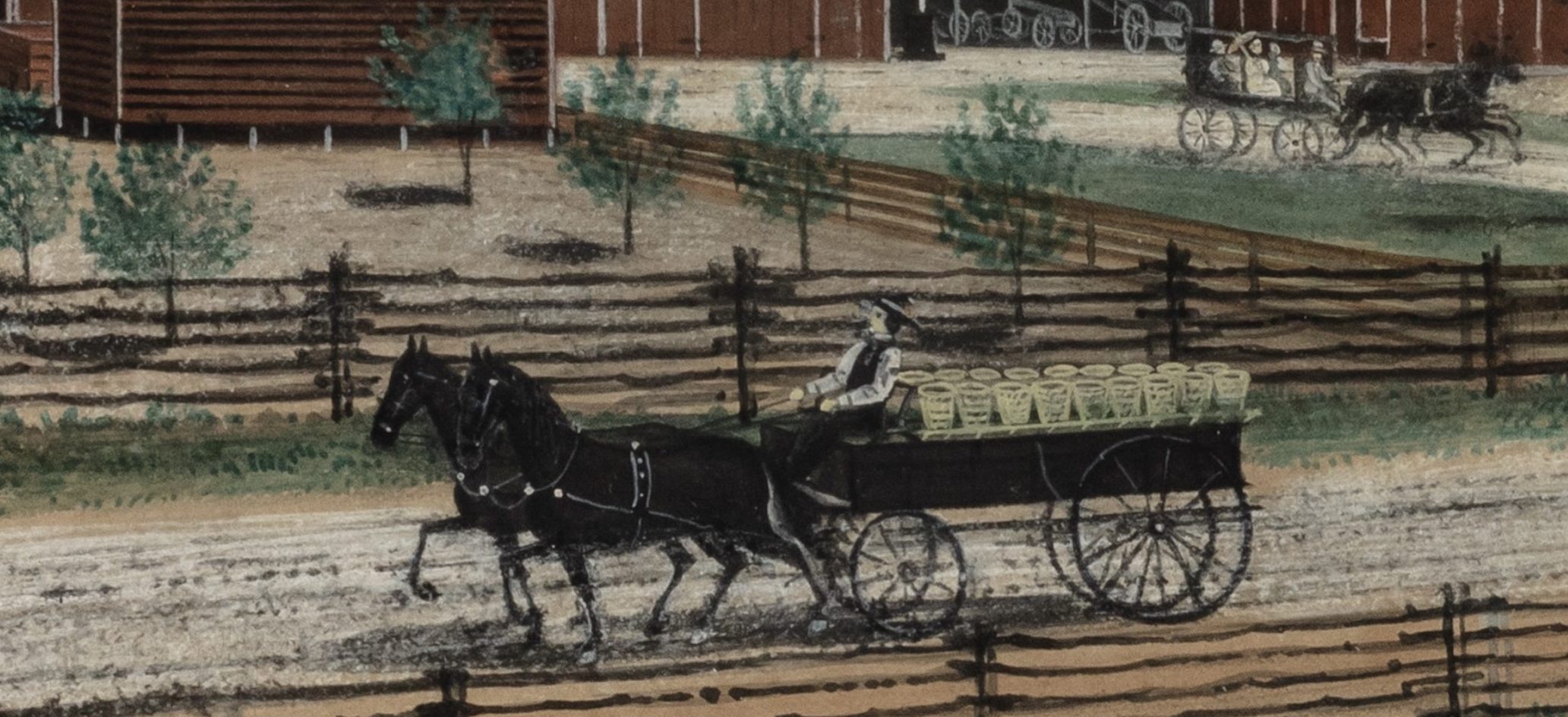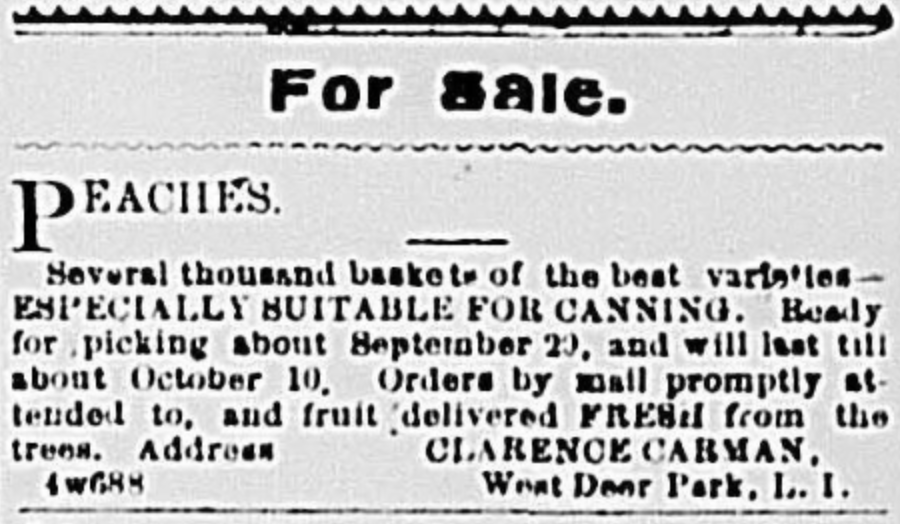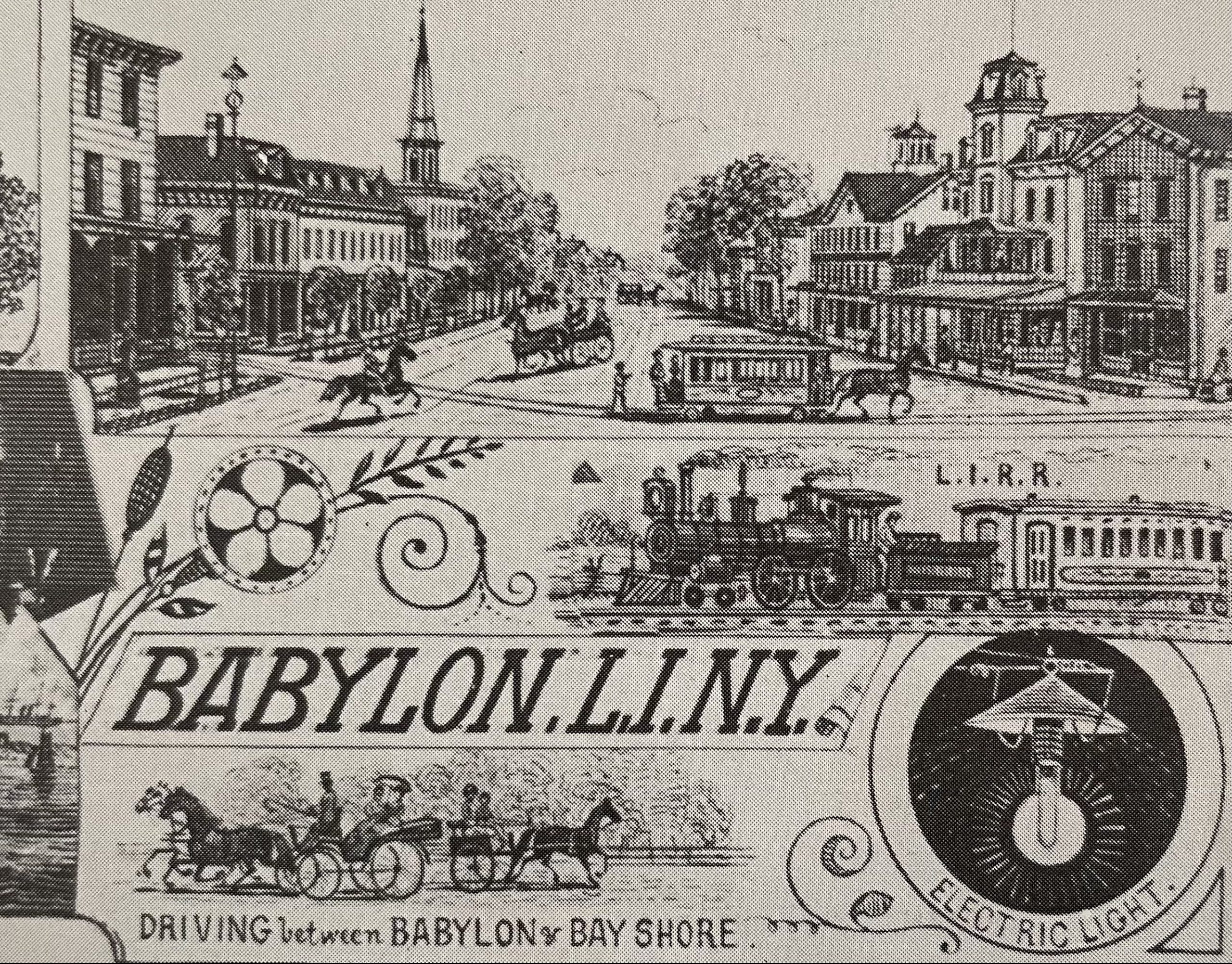Clarence Carman, Dix Hills Peach Farmer
Edward Lange (1846-1912), Carman's Peach Farm, n.d., Watercolor and gouache on paper, 17.1875 x 24.125 in. (framed), Huntington Historical Society, 1990.2
The agricultural technological revolution wrought an unprecedented increase in farming efficiency. As technological advances in farming equipment exploded over the course of the nineteenth century, the dynamics of North American agriculture changed forever. Large-scale farms in the West monopolized the market and threatened to drive small-scale farmers out of business if they did not adapt. Clarence Carman, a grain farmer of Dix Hills, faced this dilemma in the mid-1870s. Determining he would be driven out of the grain market, Carman abruptly pivotted to cultivating peaches and found tremendous success.


(left) Detail, Edward Lange, Carman's Peach Farm, n.d.; (right) Article, South Side Signal, 16 September 1882, page 3
Within five or six years of making the transition, the grain-farmer-turned-peach-farmer boasted an orchard that contained an astonishing 3,000 peach trees of over ten different varieties. One report in the South Side Signal indicated that his farm had produced several thousand baskets of peaches and expected several more thousand before the 1882 season had ended. Each of these baskets sold for $1.25 apiece. Carman added additional profits by maintaining fields of more traditional vegetables, like potatoes. To all of this, the editor at the South Side Signal wrote, "In a word, we think Mr. C. has solved the problem as to whether farming on Long Island pays, and others should profit by his example."
 By 1887, Carman was selling an average of 100 baskets of peaches daily and actively taking orders from members in his community. The local paper noted that "all wishing fruit [from Mr. Carman] should call on E.E. Bassett, at the store of Smith & Hendrickson, Babylon, L.I." Lange presented Babylon, pictured here in another sketch, as a center of progress and innovation. Carman's dealings between his farm in Dix Hills and the towns of Babylon and Bay Shore were so extensive that he decided improvements to the roadways connecting the two were in desperate need. In addition to funding this new road, Carman heavily lobbied his fellow townspeople to support the construction of a new cross-Island railroad. In Carman's case, his entrepreneurial adaptation directly brought about interest in developing new systems of transportation that supported local economies.
By 1887, Carman was selling an average of 100 baskets of peaches daily and actively taking orders from members in his community. The local paper noted that "all wishing fruit [from Mr. Carman] should call on E.E. Bassett, at the store of Smith & Hendrickson, Babylon, L.I." Lange presented Babylon, pictured here in another sketch, as a center of progress and innovation. Carman's dealings between his farm in Dix Hills and the towns of Babylon and Bay Shore were so extensive that he decided improvements to the roadways connecting the two were in desperate need. In addition to funding this new road, Carman heavily lobbied his fellow townspeople to support the construction of a new cross-Island railroad. In Carman's case, his entrepreneurial adaptation directly brought about interest in developing new systems of transportation that supported local economies.


![[Carman_s Peach Farm], Huntington Historical Society, 1990.2_cropped.jpg [Carman_s Peach Farm], Huntington Historical Society, 1990.2_cropped.jpg](https://d1y502jg6fpugt.cloudfront.net/61413/archive/fullsize/8e90c7b3c3302e74e222dcd256f7b75b.jpg?Expires=1715817600&Signature=u2DCt-pzGK4NS4HvD0UtTAfUIL0so3iN6YJzsCG1cOMjxOhwm-5RKVkiVfhH4L7wcF8TLoHTB9bKVEKlkeFjNHcbHCoF3aKJaIM3%7Ey7fSLO9sq0JaC05s16V2fl%7EbNYnfgGVNN3kkDyUDBMKoW41x2w27lGx-p1f075NlGaoxrmOqfxKbpdehX2ZnY2o4LnU7drdEd7s7cuUS3eXQiK89%7Edw4KX1xkrhgMxvLGvHcIazFjGs7bNJJmk2xfvlHnSDT3em3ZYcTCkpWl5E8hATzd31P0ew6mr4N41f4hNB6cJ4l0z%7ETTZoBnZj7FxULwZFbN1GL3gk2toNdIH5ic8-Qw__&Key-Pair-Id=K6UGZS9ZTDSZM)